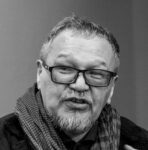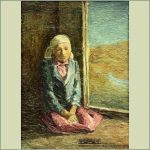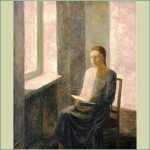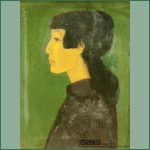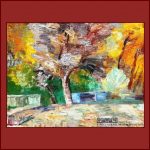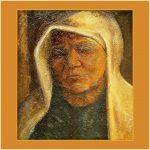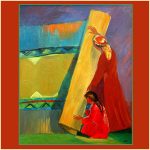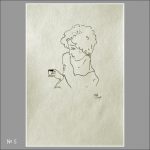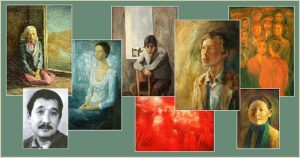
This is the second part of the review of the works of the artist Murat Bekjanov (born in 1946) from the collection of the Kyrgyz State Museum of Fine Arts named after Gapar Aitiev. As in previous issues of the reviews, in it we present the view of art critic Gamal Bokonbaev.
In the second part, as in the first, you can see 9 works of the artist.
MURAT BEKDZHANOV (born 1946) is a Poster artist. The painter. Honored Worker of Culture of the Kyrgyz Republic. He was born on November 17, 1946 in Tokmak. In 1966, he graduated from the Frunze Art College, in 1972 – the graphic faculty of the Moscow Art Institute named after V.I. Surikov, the poster workshop of N. Ponomarev. Since 1976, he has been a member of the Union of Artists of the USSR. The works are in the Kyrgyz National Museum of Fine Arts named after G. Aitiev, as well as museums in the CIS (Information from the website of the museum named after G. Aitiev)
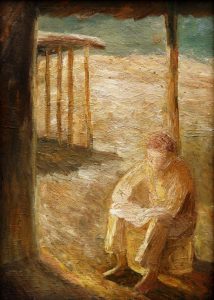 Morning. Oil on cardboard, 70.2×50.8, 1982
Morning. Oil on cardboard, 70.2×50.8, 1982
Early spring, morning, the sun warms pleasantly, does not blind, and, sitting on the veranda, you can read the newspaper, the latest news and smart articles about the fusion of the city and the village. And dream of a village in which it will be comfortable for a modern young person to live: an artist, a teacher, an intellectual. And there is no need for multi-story buildings made of reinforced concrete – you can create a stylish modern design from poles and straw! Laconic, fragmentary, ideal! The wall of the house and the roof create a frame for the opening view of a unique portico. The earth, like a floor; the sky, like walls; shadows, like elements of the structure. The drawing, cleaned up to a scheme, is enlivened: tone, texture, the finest shades. As a basis – Japanese simplicity and the metaphysical spaces of Giorgio de Chirico *. And the ayil, together with the post office and other communal amenities, receives: modernist design, universal graphics, a new understanding of life as the beauty of simple forms, without tiresome decor, all these pillows, elephants, kitties. This is elementary vulgarity! “Is it really so difficult to understand? After all, it is in our hands to make life interesting.” What a wonderful picturesque utopia! It will be pleasant for a minimalist artist to live here, but it is unclear: how does all this work and how does it pay for itself financially? In Soviet Kyrgyzstan of the 80s, they believed in this utopia, but now – no. And in the 21st century, in the Kyrgyz Republic, the process of merging the city and the village is underway! The city is becoming like a large village.
*Giorgio de Chirico (1888-1978) – Italian artist, founder of metaphysical painting, predecessor of surrealists. The influence of antiquity and the Renaissance is felt in his works. Putting a secret meaning into soulless objects, trying to reveal their true intention, combining the incompatible and playing with the subconscious, he became the harbinger of one of the large-scale trends in the art of the twentieth century – surrealism.
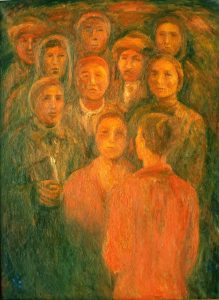 At the Mirror. Canvas, oil, 120×89.7, 1980
At the Mirror. Canvas, oil, 120×89.7, 1980
An elderly woman stands in front of a mirror and sees behind her reflection the reflection of many people who are no longer there. This is a memory of those who have passed away… These are not relatives – colleagues at work, comrades in the construction of a new country! It was with them that she went through (symbolically) the Revolution, the Civil War, the Great Patriotic War, worked to restore the destroyed national economy. Among her friends there is a very young girl in a Tebetei*, there is a short-haired girl in a tunic. All Komsomol members, probably, some of them are party members. Simple workers – not bosses. There are also older friends with books in their hands. The working intelligentsia! They are all gone, but she remains. And at the end of her life, her beloved girlfriends, friends and colleagues come to her in the reflection of the mirror… Soviet flavor – the contrast of orange-brick – Khrushchev – and gray-green – panel – shades. Brutal, stern faces. A stern Soviet man! Nowadays, there is nothing strange about an elderly woman seeing ghosts in the mirror in the evenings. A typical thriller. But back then, a painting could raise questions from the authorities and could become the basis for a discussion among intellectuals! What is it about? Is it Soviet mysticism? It’s good that such liberties were allowed back then. And artists pushed the boundaries of what was possible with their talented works: viewers were interested, and the authorities approved. It was considered that this was socialist romanticism of the era of developed socialism: the content is unambiguous (it’s clear what it is) – any form, but without extremism. A painting will be bought by a museum in the 80s, but now its meaning is difficult to explain to young people.
*Tebetey is a Kyrgyz headdress in the form of a velvet cap trimmed with marten fur or other
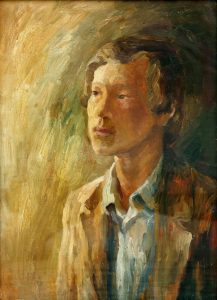 Portrait of Temir. Canvas, oil, 70×50, 1977-1980
Portrait of Temir. Canvas, oil, 70×50, 1977-1980
“A pale young man with a burning gaze…”* is dressed in a simple suit, without a tie; the top button of his shirt is unbuttoned; unruly forelocks are spread out in different directions. Beautiful with the energy of a young man of the Renaissance of Kyrgyz culture. Not a quiet one, and not a careerist, wants to understand – where is the truth? Ready to argue with anyone who does not agree with his ideas. The artist really succeeded in the eyes, inquisitive, expecting an answer. The lips and naive childish chin are precisely sculpted. A wonderful realistic picture, there is character, plasticity, energy! Here is a clear appeal to realistic methods, but on a different level! The background is expression and there is no need to lick the brutal texture – the movement, impulse, uniqueness will disappear! And what is the actual difference between modernism and realism? And why is realism bad? The main thing is to be talented about the new in a new way. If the artist had called his work “Portrait of a Komsomol Member”, then the conversation would have been completely different (how much the title influences perception!). But Temir does not look like a Komsomol member. Maybe he is a Komsomol** member formally: everyone was a Komsomol member back then. But he is too restless, somehow unpolished and looking for answers to metaphysical questions! And even if he does not find the answers, young people should be like that… And young artists can be advised to turn to nature more often. Another thing is that no one will buy a portrait of a stranger today and they have to compose… They work from life! But what it is needed for – we have forgotten. The artist and theorist Konstantin Shkurpela defined this situation as follows: “In the 70s, they did not make pictures about nature, but they had nature in them! Nowadays, they work from life, but there is no nature in the works!” … The author of the portrait saw in life what in the “vague dream” of the imagination “was still unclearly discernible” – he saw a specific form and captured the idea! This is what it was like – the youth of Kyrgyzstan in 1980!
You can add: even abstraction is useful to do from life! Artists have no choice but to compose a great story and great pathos. Invention is needed! I remember the work of Satar Aitiev “Youth of Kyrgyzstan”. And it seems that there is mockery, an anti-poster. The controversy between the paintings makes Murat’s work sublime. Skepticism is needed, a positive mood is needed. There is no mockery here as in the works of Satar Aitiev. Judging by the dates of creation, the artist made this portrait for 3 years! It is hard to believe… Probably, the attributes suffer from inaccuracy.
*Quote from the poem by V.Ya. Bryusov
**Youth party organization of the Soviet era
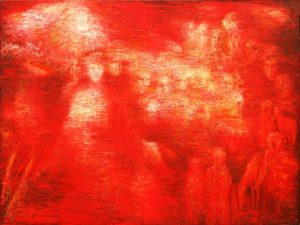 Sun. Canvas, oil, 150×200, 1977
Sun. Canvas, oil, 150×200, 1977
The sun rises and illuminates the assembled people with its rays. The light falls on a part of the hill, on some faces and figures. On the left, one can guess a horse, a man in a tebetei; in the center, a group of people; on the right, women in elecheks, a mare with a foal. They all appear as if from memories. Some are in the light, some in the shadow. But there is no shadow as such – everything is in light reflections, in shades of red with small inclusions of white and brown. One recalls the story by Kubatbek Jusubaliev “The Sun Has Not Finished Its Self-Portrait” (1967). According to the artist, the sun brought light! And warmth! It could not help but bring it – it is the sun! The polemic with the works of Satar Aitiev is implied: “Dedication” (1972), “Poets” (1973). Satar is tougher, his favorite theme is the theme of hopelessness… The work of art can be viewed in different ways. We can say that this red sun of the socialist revolution woke people up from the centuries-old sleep of the Middle Ages; that this is the Renaissance after the cold winter of 1916! Or perhaps this is the spring Victory Day in the Great Patriotic War of 1945! It can be interpreted in different ways, and all this will be significant as research. But what exactly is this picture about? It is not clear! The lack of a specific address will become a weakness of Kyrgyz Soviet modernism… Wait. Or maybe this is how it is seen from our time? And then hinting at the events of 1916 was really bold! It turns out that in order to appreciate this talented work, you need to completely immerse yourself in its time! But is it possible? And is it necessary? This artistic experience is not needed now. And speaking in bird language is no longer required. Today, artists need to speak out directly and to the point!.. We need to postpone for the future the analysis of this wonderful work, which speaks in hints about a lot and… about nothing!
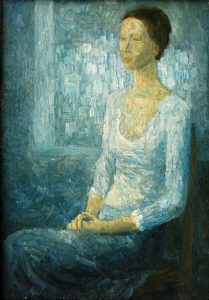 Girl in Blue. Canvas, cardboard, oil, 50×70, 1977
Girl in Blue. Canvas, cardboard, oil, 50×70, 1977
A girl sits surrounded by blue walls. Outside the window, a blue city is located on a hill. Is it a one-story terraced building? I can’t understand. We don’t have anything like that. And not Moscow, and not Paris. Fantasy! “People sometimes dream of blue cities that have no name.” That’s what they sang in the USSR in the 70s… Reflexes make a white jumper blue. And in contrast to the blue – brown – a wooden chair, a brunette. Brown is warm, alive. It fights the cold and warms the model with transparent, delicate, flesh-colored shades. The magical girl glows and smiles mysteriously, but her green eyes are still empty. And the feeling of unnaturalness does not leave: winter cold and a warm body, fantasy and dusty crystal, proud posture and disproportions of an accelerator. Not Galatea, and not Mona Lisa, and not the Snow Queen. Not grown up. And it will not grow up, because the glass coloring resembles the color of green Soviet kefir bottles. The princess of glass containers against the background of a glassware collection point. The artist fights for the right to develop the category of dissonances in art and in life, although there is no such aesthetic category in Soviet art criticism. The painter experiments on the edge of artistry, explores the concepts of the “unnatural”, “inappropriate”. He is not afraid of anything and climbs into the darkest corners of the subconscious. The author has the right to do this, but it is offensive for the blue fantasy and a little pity for the girl.
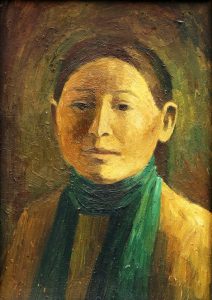 Girl in a Green Scarf. Cardboard, oil, 49.5×36, 1976
Girl in a Green Scarf. Cardboard, oil, 49.5×36, 1976
The roundness of the face is emphasized by the side lighting. Shades of ochre: from bleached to greenish-brown. The green scarf wrapped around the neck stands out. Live observations from nature and a generalized image – national, Soviet, and, of course, modernist. The form is simple and the image is simple – energetic, friendly, welcoming! She looks clearly and smiles slightly. The cycle of portraits created by Murat Bekjanov, Satar Aitiev, Aman Asrankulov, Jambul Jumabaev are images of the urban culture of the 70-80s. As a rule, these are not celebrities (not professors, not writers, not heroes of labor) and they are attracted by some one formal feature. As in this case – a green scarf. It is better to engage in formal searches in the style of urban primitive than to glorify assemblers, winders, knitters … Paradox: they denied pathos, but came to spirituality! How so? Maybe the halo above the girl’s head is “to blame” for everything? Although, most likely, this is a senseless adherence to form: the halo was needed for the composition. Don’t rush! Or maybe this is a unique Soviet religiosity? This is when an atheist mentions Golgotha (or Fujiyama) and rants about how everyone should bear their cross, not really understanding what is being discussed here. That is, understanding! But in their own way. Picturesquely suffering for all of humanity, reluctantly building communism, in order to then drive everyone into it like sheep! Thankless work… Or maybe everything is simpler and higher, and this is a portrait of how every girl is like an angel waiting for a simple human miracle.
 Girl in a Yurt. Cardboard, oil, 50×35.4, 1975
Girl in a Yurt. Cardboard, oil, 50×35.4, 1975
The famous art critic Olga Popova wrote about this work: “The artist also solves spatial problems in the painting “Girl in a Yurt” (1975). The work is done in a sketchy manner, the volumes in it are sculpted without detailing, the color relationships are taken in a generalized manner.”
A girl is sitting at the threshold in the yurt, with her legs tucked under her. She is wearing a pale pink dress, a pale yellow headscarf, and a pale blue jacket. Ochre dominates, with pale green and pale blue arguing with it. The sky, mountains, hills, foothills, and a river are visible in the opening. If it weren’t for the title, one might decide that the interior of a mountain house is depicted: the jamb is too even, the angle is too right. What interested the artist in the girl? She is not the famous “Daughter of Soviet Kirghizia,” not a hero or a symbol. The author understands: there is no point in reviving the ideals of a bygone era. Not everyone will go to study in Moscow, not everyone will become an academician, like Altynai from Chyngyz Aitmatov’s story “The First Teacher”. This girl is quiet, modest, not brave, not combative. She dressed up, poses, the collar of her dress is too wide for her thin neck; the jacket was taken out of the chest, where “dress” peasant clothes are folded, mixed with mothballs. The artist did not in vain include a raging river in the composition. Talent does nothing for nothing. He wants to say that this girl is like this river: she gathers in small drops, becomes a modest stream, rumbles a little along the gorges and then spills out as a fertile full-flowing river along the blooming valley! And her flow will be unstoppable! But for now she sits quietly, and does not even suspect what energy is hidden in her and this is what makes her interesting! Unrealized opportunities! She is like a people who do not demonstrate their spiritual power over trifles and only show it in times of trial. But for now they are embarrassed and timid.
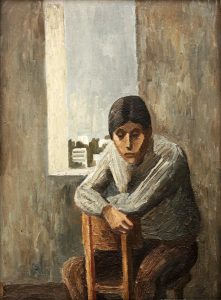 Portrait of the sculptor Mergenov Erkin. Canvas, oil, 70×50, 1974
Portrait of the sculptor Mergenov Erkin. Canvas, oil, 70×50, 1974
This is how the famous art critic Olga Popova wrote about the artist’s works: “In the 70s, Murat Bekjanov established himself as a subtle portraitist, who did not remain aloof from formal searches. The logic of the formal-spatial solution (a clear rhythm of different tones, planes close in color, organizing the space) of the portraits creates a certain psychological mood associated with the character and spiritual appearance of the models (“Portrait of the sculptor E. Mergenov”, 1974; “Girl illuminated by the sun”, 1974)” … Mergenov Erkin (1940-2015) is a Kazakhstani artist and sculptor. In 1973, he graduated from the Moscow Art Institute named after Vasily Surikov, the sculpture department. Murat graduated from the graphic department of the same institute in 1972. At the time of painting the portrait, Murat was 28 years old, Erkin – 34 years old… A small, laconic work, but how much is said! About a friend, about time, about himself. The young man is alone in the room; he sits strangely (on two seats?), hugging the back of the chair with his arms. Here is a statement! A claim to unusualness! He lowered his eyes, thoughtful. Everything is simple, even, clean, as if combed; a white striped sweater, corduroy brown jeans. Even the curls of plaster are laid vertically and smoothed. The desire to start from scratch, from order, from the elementary, from architecture, from construction. And the window is not a window! It is a conventional opening, a connection between the inner world and the outer. With the urban landscape, high-rise buildings, drowning in greenery. Is this Frunze? Alma-Ata? Moscow? Or maybe it is in France? In Le Havre? Or in Italy? In Milan? The generation will dream of modernist purity of form, as if there is peace in form. Dream of the right, of rules. Wanted something stylish, European. We waited all our lives and never got it. It won’t work: neither in construction, nor in architecture, nor in design. It will work in painting! In the purity of lines – purity of thoughts.
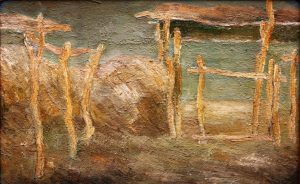 In the steppe. Oil on cardboard, 39.5×63.2, 1973
In the steppe. Oil on cardboard, 39.5×63.2, 1973
The work of a twenty-six-year-old artist. A year ago, the author graduated from the graphic department of the Moscow Art Institute named after Vasily Surikov. Autumn, twilight: shades of gray and ochre dominate. A haystack (or an adobe wall?), a fence and gate made of poles, a corral for cattle. Nothing else is visible, no people, no domestic animals. There are no pictorial contrasts: the light would be brighter and the shadows darker. But the young artist caught the trend and joined a fascinating experiment: creating the foundations of Kyrgyz major modernism. He understands: you need to break all the generally accepted rules. You need to see only what attracts you, even in fragments. Painting or graphics? What’s the difference, really? Painting is brutal graphics, with the inclusion of pale shades. More oddities and less socialist realist temperament – that was in fashion then: the artist immediately became interesting and bold, and museums bought such works. No kidding: the author boldly and honestly saw a deserted ruined collective farm in the steppe and saw nothing else, and found himself one level above the varnishers of that, Soviet, reality. The Soviet author dodged ideology, the intellectual did not become ironic, and the urban artist played a suprematist* game of rectangles made up of… poles. In addition to the poles, there is a rectangle of a haystack on the left, a rectangle of earth below, a dark rectangle of the shadow part of the canopy above, and a greenish rectangle of the sky. The entire composition is a contrast-nuance of rectangles. A subtle, intellectual game! But is urban suprematism appropriate for conveying subjective impressions of the steppe landscape?
*Suprematism is a movement in avant-garde art founded in 1915 by Kazimir Malevich. It is a type of abstractionism and is expressed in combinations of multi-colored planes of simple geometric shapes such as a straight line, square, circle, and rectangle.
<= ISSUE 15 TO BE CONTINUED
Telegram-channel in Kyrgyz & Russian:
Санжарбек Данияровдун коомдук фонду
Фонд Санжарбека Даниярова
Subscribe if interested




